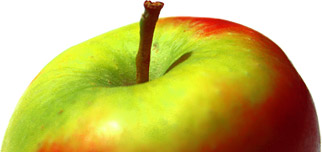Discovered by Oregon apple enthusiast Lon Rombough, growing as a seedling tree by the side of a road near West Salem. It was given the name 'Apricot' because of the apricot-like flavor. Here is Lon's description of how he found it:
"Apricot" is an apple I found as a chance seedling in the 1980s. It was the day after Thanksgiving and I was giving a ride to a visitor. We went up a gravel back road in a rural area west of West Salem, Oregon. There were three chance seedling apples barely surviving along the edge of a field and one caught my eye for the amount and appearance of fruit on it. I stopped and tried it. It was good enough that I took scions. The tree had lost most of it's leaves already, so I figured the wood was dormant enough to survive. It was, and I was able to get trees started.
I move in 1989 and for years had the variety only as a grafted limb on an older tree. In early 2006 I topworked a seedling tree with it.
The tree of "Apricot" has good vigor, but the internodes are short. My tree topworked to a seedling has lots of shoots, but they tend to be rather compact or spurry in appearance. The topworked tree is in bearing just two years after being grafted. That was a nice surprise because while trees of it on dwarf stocks came into bearing in two years or so, I was concerned that it might be slow to bear as a standard tree. The precociousness seems to be helped by a tendency to bearing on shoot tips, though it bears on spurs too. It needs thinning to get good size, but hangs very well on the tree.
As the photos show, the flesh has an orange-yellow look to the flesh, which, combined with the apricot-like aftertaste was why I named it "Apricot" apple. The flesh color and the convex calyx end are two distinct features that help identify the variety. The only other apple I've seen with a similar combination of yellow flesh and convex calyx was an old one called "Smokehouse". The flesh is somewhat coarse, even moreso this year, possibly due to several days of rain before I took the photos. The apricot-like aftertaste was less distinct this year, too, also probably due to the rain.
The fruit shows very little scab, to the extent that it could at least be considered highly tolerant of that disease if not outright resistant.* I've yet to see mildew on it, either.
The fruit ripens late, and hangs a long time. It should be left as long as possible to develop it's distinct flavor.
I've been told that there is a commercial grower growing and selling "Apricot" in Waukesha, Wisconsin, so the variety must be fairly hardy.
No way of knowing how much chilling "Apricot" needs, but since California Rare Fruit Growers members have been including it in apple tastings, it's able to grow in some parts of California, at least.
Of course the place where the original tree grew has been turned into a housing development, with paved streets and sidewalks where there was a gravel road.
*Experience in the very wet summer of 2010 shows that Apricot will succumb to scab in wet conditions.
Lon Rombough sells graftwood of Apricot apple on his website - see www.bunchgrapes.com.
USDA identification images for Apricot
The identification paintings in the USDA Pomological Watercolor Collection span the years 1886 to 1942.
Citation: U.S. Department of Agriculture Pomological Watercolor Collection. Rare and Special Collections, National Agricultural Library, Beltsville, MD 20705.
Visitor reviews
- 16 Dec 2011 CO, United StatesWe grow the apricot apple (and sell scionwood), it is an every other year producer, nice, unique fruit...ripens in mid-october in CO. It is one of our favorites, but the apricot taste is fairly weak...just a nice unique flavor.
- 28 Mar 2011 WISCONSIN, United StatesApricot is my absolute favorite apple. It's flavour and fragrance are intense and it is extremely hard and late to ripen. We have been buying the apples and new grafts from Westons' Antique Apple Orchards in New Berlin, Wisconsin.
- 09 Jul 2010 MN, United StatesWe grow the apricot apple. It's a gem. It's a mid-season apple and has an apricot fragrance. That strong fragrance comes through in eating too. At the Mill City Market last year, we sold out in about forty-five minutes. Our customers were stopping shoppers and telling them that they had to try it!
- 01 Jan 2010 United KingdomStarter post
Tree register
United States
- Albany Appleguy in Castleton, NY
- Axel Kratel in Santa Cruz, CALIFORNIA
- Jerry Hudgins in Point Reyes Station, CALIFORNIA
- Lon Rombough in Aurora, OR
- Rick Simoniello in Storrs / Mansfield, CT
- Stephan Orchard in Westfield, INDIANA
Spring blossom records for this variety
2020 season
- 18th April 2020 - tree owned by Jerry in Point Reyes Station, United States
2019 season
- 19th April 2019 - tree owned by Jerry in Point Reyes Station, United States
2018 season
- 22nd April 2018 - tree owned by Jerry in Point Reyes Station, United States
2011 season
- 12th May 2011 - tree owned by Lon in Aurora, United States
Record your blossom dates in our Fruit Tree Register - more >>.
Harvest records for this variety
Origins
- Species: Malus domestica - Apple
- Originates from: West Salem, Oregon, United States
- Introduced: 1980s
- Developed by: Lon Rombough
Identification
- Country of origin: United States
Using
- Food uses: Eating fresh
Growing
- Flowering group: 4
- Ploidy: Diploid
- Vigour: Average vigour
- Precocity: Precocious
- Fruit bearing: Partial tip-bearer
- Self-fertility: Not self-fertile
Where to buy fresh fruit
The following orchards grow Apricot:
United States
New York
Canada
British Columbia
- Apple Luscious Organic Orchards, Salt Spring Island
- Salt Spring Apple Company, Salt Spring Island

